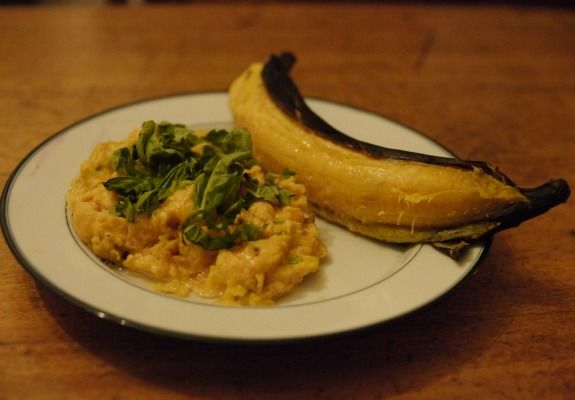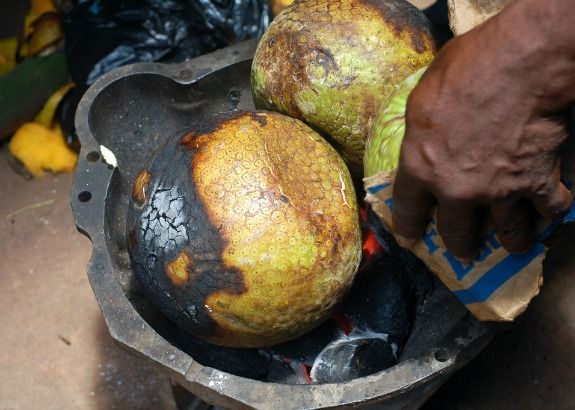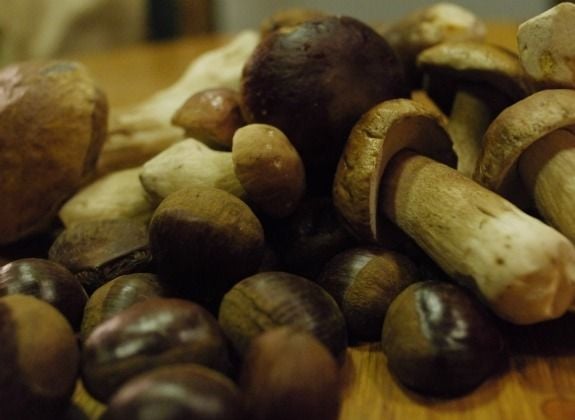Exotic Dishes to Spice Up Your Thanksgiving Feast
Add some global flair to your banquet with these savory variations on your favorite “Turkey Day” fare
/https://tf-cmsv2-smithsonianmag-media.s3.amazonaws.com/filer/20121120023107ThanksgivingDuckSMALL.jpg)
Thanksgiving dinner may be the supreme all-American meal, and it’s surely one of the most satisfying feasts that ever has come across a table. It’s starchy, greasy and meaty; it’s both savory and sweet; it’s massive—and usually a sure recipe for leftovers. One could argue that a table set for Thanksgiving lacks in nothing. But we could likewise make the case that a Thanksgiving dinner is one of the most predictable buffets of Americana. Mashed potatoes, stuffing, gravy, cranberry sauce, pumpkin pie and, of course, an absurdly overweight turkey all have their rightful places on the Thanksgiving table. But would it entirely upend a revered culinary tradition to add a little exotic variation to the feast? From turkey to pumpkin pie, Peru to Tahiti, these dish-by-dish suggestions will spice up this Thursday’s banquet with some global flair and fare.
French duck. Turkeys—especially monstrous ones so fat and fleshy they cannot fly—are as American as apple pie, Chevies and suburbs. While Europeans have gained a taste for our largest native fowl, other birds have traditionally taken the seat of honor at their dinner tables. In much of France, the bird of choice is the duck. Now be warned: Most of the guests on your invite list have been waiting all year for their turkey, and if you screw it up they might mob you—so only replace the turkey for a small or particularly adventurous crowd. Ducks are only a fraction of the size of a Thanksgiving turkey, often with far less meat and a thick layer of fat. Don’t expect much leftovers, even if—as might be wise—you serve two ducks. To cook, try this: Brown some hand-sized cuts of the duck with shallots and onions in a Dutch oven over a medium flame. Then add Belgian beer, dried fruit and dried herbs, put on the lid and bake for two hours. Or you might spice up the bird with ginger, green onions, garlic and sesame oil for an Asian presentation.
Peruvian mashed potatoes. The origin of Solanum tuberosum, Peru is home to thousands of varieties of potato, some of which are available in America and, mashed with milk and butter, can add color and flavor to what may be the blandest dish on the table. For a dramatic presentation of mashed potatoes, try a purple potato. In taste and texture, the dish will be negligibly different than the one you grew up on. If you wish to take the same concept a step further, separately mash and season a batch of yellow potatoes. Then, fold the two mashed potato purées together in the serving dish, leaving layers of color.

Nigerian yams. Almost everyone loves yams on Thanksgiving—or at least they think they do. Because “yam” is a misnomer commonly applied to the sweet potato (Ipomoea batatas), another Peruvian native. You want a real yam? Then look straight to western equatorial Africa, where four-foot-long tubers weighing as much as 100 to 150 pounds are a staple carbohydrate for millions. The vegetable, which is celebrated with annual festivals, consists of multiple species in the genus Dioscorea. Africa’s white yam (D. rotundata) is the most popular and important species, and, like sweet potatoes, may be baked or boiled for starchy, semisweet results. Yams are grown throughout the Caribbean where African cultures took root (sorry) several centuries ago. Some are exported, and in the United States this huge vegetable is available in some Caribbean and Asian supermarkets.
Belizean baked plantains. The sweet syrup that leaks from the splitting skin of a hot baked yam—I mean, sweet potato—is one sure signature of the fourth Thursday in November. But along the belt of the Equator, an abundant local alternative produces a similarly delicious result: a baked plantain. This banana-like fruit, though often eaten as a savory starch source, can be left to ripen until black in the skin and soft in the flesh, which will by now be sweet and sticky. Cooking plantains as a sweet potato alternative is a cinch: Put them in a metal baking dish and bake at 400 degrees Fahrenheit for 15 or 20 minutes. When that syrup starts bubbling, the plantains are done. To serve, peel open the fruits, and the steaming flesh will fall onto the plate. Now, season as you would a yam—or melt coconut oil onto the fruit for a stronger exotic accent. Plantains grow throughout the tropics, but I name Belize as the origin of this dish simply because that’s where I first learned to make it.

Turkish fig-and-cranberry chutney. Messing around with the cranberry sauce is not as likely to draw unfriendly fire from expectant diners as, say, replacing the turkey with a scrawny avian cousin, so take this idea as far as you want. Following a Turkish theme, add dried brown figs—a major product of the nation—to your usual cranberry sauce recipe. Then, go incrementally further, ingredient at a time, to make a spice-laden chutney. Simmer the cranberries in a cup of fortified red wine (a.k.a. Port) and begin adding elements of the East: Dice and toss in the figs, some lemon and orange zest, garlic, ginger, cloves and cumin. Sweeten with honey and, after the stew has cooled, garnish with chopped mint and serve.
Tahitian stuffing with breadfruit (or taro) and coconut. Your guests may sulk at the sight of a nontraditional stuffing, so approach this idea cautiously. The theme takes us to the Pacific islands, where, lacking the culture and systems of grain cultivation, many societies rely on breadfruit as a major carbohydrate source. Cooked in its earlier stages of ripeness, this round, green, thick-skinned treefruit somewhat resembles a pineapple, but the fruit inside is as starchy and savory as bread or potatoes. Cooking breadfruit is easy; grilling or broiling thick slices with a little olive or coconut oil is a simple method. The challenge, however, may be finding the things, as our blog “Food and Think” reported three years ago. If you can’t find one of these exotic fruits, go underground for a similar result with taro, a starchy tuber of the tropics and also grown in Tahiti. Peel and halve the roots, then bake until steaming and tender. Use the breadfruit or taro as the bread in your favorite stuffing recipe. If you want some tropical sweetness in the dish, you can add cubes of fresh coconut and pineapple.

Italian porcini-chestnut gravy. Where chestnuts fall, porcini rise. That’s because Italy’s favorite mushroom happens to prefer the roots of the chestnut tree as its mycorrhizal companion, and for one who wakes early to beat the competition, a walk in the woods in November can provide a double whammy of wild gourmet loot. The mushrooms are considered relatively unmistakable, with no dangerous look-alikes (but if there’s any doubt, throw it out) and chestnuts, well, they’re as easy to harvest as pine cones. At home, de-husk the chestnuts, bake and peel. Using a blender or a hand potato masher, make a smooth paste using half the batch. Coarsely chop the rest of the chestnuts. For the mushrooms, brush off the grit, slice and dice, then sauté in olive oil until brown. Make the gravy as you normally would, using bird broth as the base and the chestnut mash as a thickener in place of flour. Add the porcini and chestnut chunks halfway through the simmering process.
Moroccan pumpkin pie. You might not subject each pie on the table to exotic experimentation, but try this idea for one: Follow your favorite pumpkin pie recipe, but reduce the quantity of molasses and make up the difference using purée of Medjool date, a variety believed to have originated in Morocco. The date is the world’s sweetest fruit, with up to 80 percent of its mass being sugar, meaning you can expect a rather seamless swap. Additionally, coarsely chop a handful of dates to fold into the pie mix. Sprinkle the pie with toasted almonds and orange zest, and you’ve got a North African rendition of America’s most sacred pie.

/https://tf-cmsv2-smithsonianmag-media.s3.amazonaws.com/accounts/headshot/Off-Road-alastair-bland-240.jpg)
/https://tf-cmsv2-smithsonianmag-media.s3.amazonaws.com/accounts/headshot/Off-Road-alastair-bland-240.jpg)